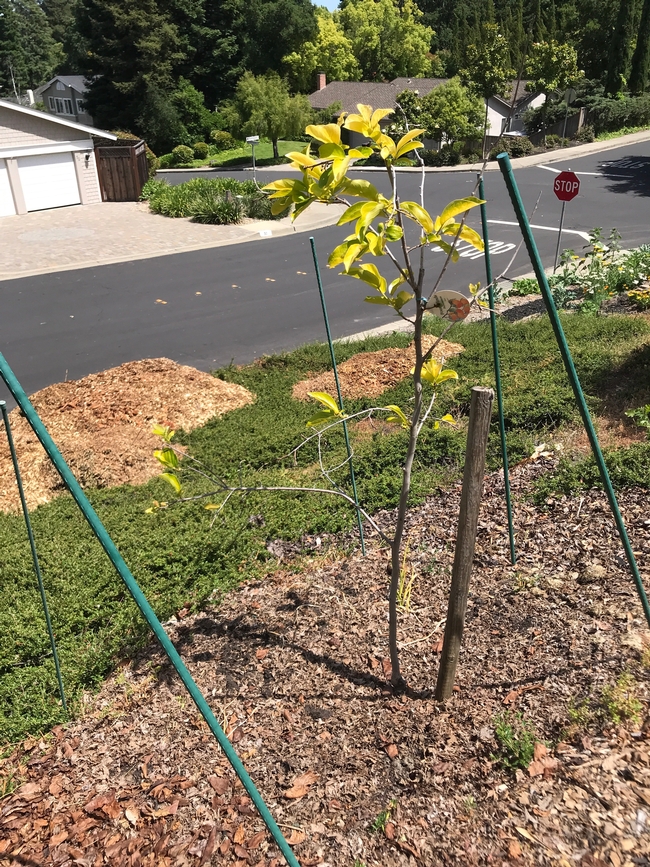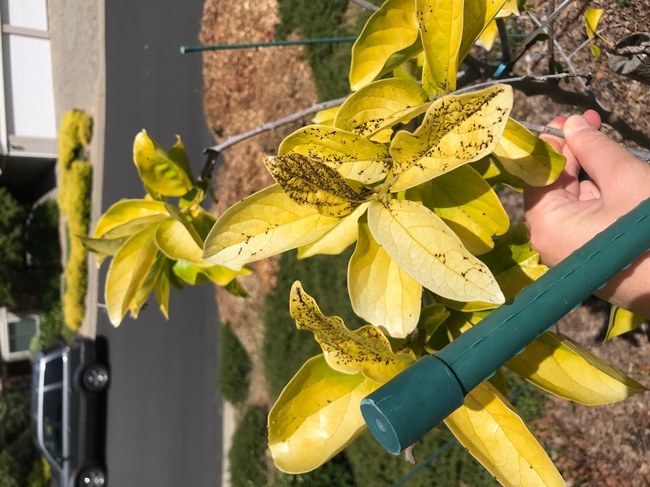Advice for the Home Gardener from the Help Desk of the
UC Master Gardener Program of Contra Costa County
MGCC Help Desk Request: What's going on with my persimmon tree? I worked a bunch of compost into the soil around it in the spring and mulched with leaves. But it looks like it needs nutrients. What should I give it? This is its third year since planting. Thanks
Persimmons are generally disease free, but the black spots showing on some of the leaves look like fungal spots. I can't tell from the photo what type of fungus, but there are several that can occasionally affect persimmons. A wet spring, such as we have had, may exacerbate this, as can overhead watering, so you should make sure any nearby sprinklers do not hit the tree. UC does not recommend any treatment other than good cultural care. Removing any fallen leaves also will help. http://ipm.ucanr.edu/PMG/GARDEN/PLANTS/DISEASES/leafspotdis.html.
As long as the spotted leaves are green, I think it would be best to leave them on the tree, as the foliage looks a little sparse - those leaves are still making food for the tree. Now we have hotter and dry weather, leaf spot fungi will be less active.
As you mention, the tree does look like it could use a little help. Persimmons don't generally need a lot of fertilizer, but yours may benefit from a balanced fertilizer for fruit trees (follow package directions ). Make sure the mulch does not cover the bottom of the trunk just above the roots - this area should be clear so that air can get to the roots. When adding compost to the tree you do not need to work it into the soil, which may risk damaging the roots. Worms and other soil creatures will take care of incorporating the compost. Persimmons don't need as much water as some other fruit trees, however, a young tree needs regular irrigation until established, and will do better later on with continued irrigation. The soil should not be overly wet, but do not let it dry out.
The following links give more information about caring for persimmons.
http://www.crfg.org/pubs/ff/persimmon.html
and
http://sonomamg.ucanr.edu/The_Kitchen_Garden/FRUITS/Persimmon/
I hope this information will help your tree to do better, and if you have any further questions, please do not hesitate to contact us.
Help Desk of the UC Master Gardener Program of Contra Costa County (SMW)
Note: UC Master Gardeners Program of Contra Costa's Help Desk is available almost year-round to answer your gardening questions. Except for a few holidays (e.g., last 2 weeks December), we're open every week, Monday through Thursday for walk-ins from 9:00 am to Noon at 2380 Bisso Lane, Concord, CA 94520. We can also be reached via telephone: (925) 608-6683, email: ccmg@ucanr.edu, or on the web at http://ccmg.ucanr.edu/Ask_Us/. MGCC Blogs can be found at http://ccmg.ucanr.edu/HortCoCo/ You can also subscribe to the Biog.